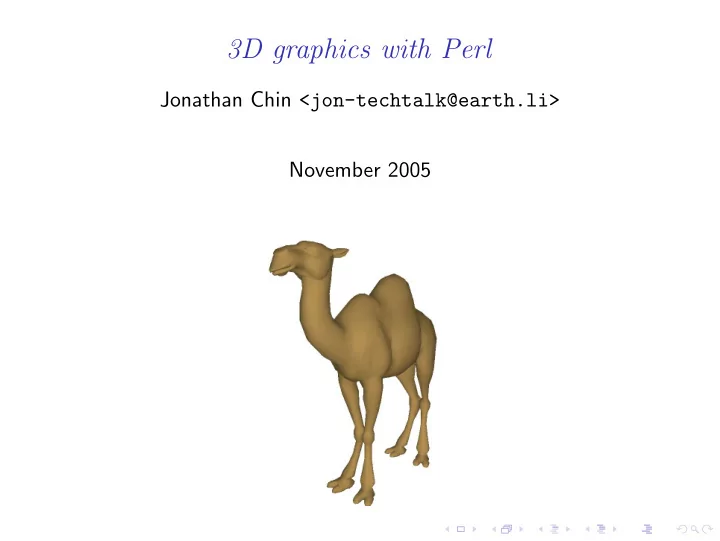

3D graphics with Perl Jonathan Chin <jon-techtalk@earth.li> November 2005
OpenGL ◮ API for real-time 3D graphics
OpenGL ◮ API for real-time 3D graphics ◮ Abstracts away the details of complicated rendering hardware/software
OpenGL ◮ API for real-time 3D graphics ◮ Abstracts away the details of complicated rendering hardware/software ◮ Standard on UNIX; competes with Direct3D on Windows.
◮ OpenGL will: ◮ Render 3d graphics very quickly.
◮ OpenGL will: ◮ Render 3d graphics very quickly. ◮ Get the hardware to do it, if possible.
◮ OpenGL will: ◮ Render 3d graphics very quickly. ◮ Get the hardware to do it, if possible. ◮ OpenGL will not:
◮ OpenGL will: ◮ Render 3d graphics very quickly. ◮ Get the hardware to do it, if possible. ◮ OpenGL will not: ◮ Raytrace
◮ OpenGL will: ◮ Render 3d graphics very quickly. ◮ Get the hardware to do it, if possible. ◮ OpenGL will not: ◮ Raytrace ◮ Deal with windowing, input, mouse/keyboard interaction
Some graphics hardware from 2002
Equivalent hardware in 2005
Talking to OpenGL from Perl ◮ OpenGL.pm
Talking to OpenGL from Perl ◮ OpenGL.pm ◮ SDL::OpenGL
Talking to OpenGL from Perl ◮ OpenGL.pm ◮ SDL::OpenGL ◮ OpenGL::Simple
Step 1: Open a window. ◮ X11 (The OpenGL.pm way)
Step 1: Open a window. ◮ X11 (The OpenGL.pm way) ◮ SDL
Step 1: Open a window. ◮ X11 (The OpenGL.pm way) ◮ SDL ◮ GTK
Step 1: Open a window. ◮ X11 (The OpenGL.pm way) ◮ SDL ◮ GTK ◮ GLUT
Step 1: Open a window. ◮ X11 (The OpenGL.pm way) ◮ SDL ◮ GTK ◮ GLUT ◮ OpenGL::Simple::Viewer
use OpenGL::Simple ’:all’; use OpenGL::Simple::GLUT ’:all’; glutInit; glutInitWindowSize(500,500); glutCreateWindow("Window title"); glutDisplayFunc(\&displayfunc); glutMainLoop; sub displayfunc { glClearColor(0.8, 0.8, 0.8, 0); glClear(GL_COLOR_BUFFER_BIT); glPointSize(5.0); glColor(0,0,0); glBegin(GL_POINTS); glVertex(-0.5, -0.5); glVertex(-0.5, 0.5); glVertex( 0.5, 0.5); glVertex( 0.5, -0.5); glEnd; glFlush; }
glBegin(GL_POINTS); glVertex(-0.5, -0.5); glVertex(-0.5, 0.5); glVertex( 0.5, 0.5); glVertex( 0.5, -0.5); glEnd;
glBegin(GL_LINES); glVertex(-0.5, -0.5); glVertex(-0.5, 0.5); glVertex( 0.5, 0.5); glVertex( 0.5, -0.5); glEnd;
glBegin(GL_LINE_STRIP); glVertex(-0.5, -0.5); glVertex(-0.5, 0.5); glVertex( 0.5, 0.5); glVertex( 0.5, -0.5); glEnd;
glBegin(GL_LINE_LOOP); glVertex(-0.5, -0.5); glVertex(-0.5, 0.5); glVertex( 0.5, 0.5); glVertex( 0.5, -0.5); glEnd;
glBegin(GL_POLYGON); glVertex(-0.5, -0.5); glVertex(-0.5, 0.5); glVertex( 0.5, 0.5); glVertex( 0.5, -0.5); glEnd;
glBegin(GL_POINTS); glColor(1,0,0); glVertex(-0.5,-0.5); glColor(0,1,0); glVertex(-0.5,0.5); glColor(0,0,1); glVertex(0.5,0.5); glColor(0,1,1); glVertex(0.5,-0.5); glEnd;
glBegin(GL_LINES); glColor(1,0,0); glVertex(-0.5,-0.5); glColor(0,1,0); glVertex(-0.5,0.5); glColor(0,0,1); glVertex(0.5,0.5); glColor(0,1,1); glVertex(0.5,-0.5); glEnd;
glBegin(GL_LINE_STRIP); glColor(1,0,0); glVertex(-0.5,-0.5); glColor(0,1,0); glVertex(-0.5,0.5); glColor(0,0,1); glVertex(0.5,0.5); glColor(0,1,1); glVertex(0.5,-0.5); glEnd;
glBegin(GL_LINE_LOOP); glColor(1,0,0); glVertex(-0.5,-0.5); glColor(0,1,0); glVertex(-0.5,0.5); glColor(0,0,1); glVertex(0.5,0.5); glColor(0,1,1); glVertex(0.5,-0.5); glEnd;
glBegin(GL_POLYGON); glColor(1,0,0); glVertex(-0.5,-0.5); glColor(0,1,0); glVertex(-0.5,0.5); glColor(0,0,1); glVertex(0.5,0.5); glColor(0,1,1); glVertex(0.5,-0.5); glEnd;
But what about 3D graphics?
But what about 3D graphics?
use OpenGL::Simple ’:all’; use OpenGL::Simple::GLUT ’:all’; use OpenGL::Simple::Viewer; glutInit; my $v = new OpenGL::Simple::Viewer( draw_geometry => sub { glBegin(GL_POLYGON); glColor(1,0,0); glVertex(-1,-1,0); glColor(0,1,0); glVertex( 1,-1,0); glColor(0,0,1); glVertex( 1, 1,0); glColor(1,0,1); glVertex(-1, 1,0); glEnd; }, ); glutMainLoop;
use OpenGL::Simple ’:all’; use OpenGL::Simple::GLUT ’:all’; use OpenGL::Simple::Viewer; glutInit; my $v = new OpenGL::Simple::Viewer( draw_geometry => sub { glutSolidTeapot(1.0); }, ); glutMainLoop; exit;
glutInit; my $v = new OpenGL::Simple::Viewer( draw_geometry => sub { glBegin(GL_POLYGON); glTexCoord(0,1); glVertex(-1,-1,0); glTexCoord(1,1); glVertex( 1,-1,0); glTexCoord(1,0); glVertex( 1, 1,0); glTexCoord(0,0); glVertex(-1, 1,0); glEnd; }, ); my $i = new Imager; $i->read(file=>’texture.png’); glTexImage2D(image=>$i); glEnable(GL_TEXTURE_2D); glTexParameter(GL_TEXTURE_2D, GL_TEXTURE_MAG_FILTER,GL_LINEAR); glTexParameter(GL_TEXTURE_2D, GL_TEXTURE_MIN_FILTER,GL_LINEAR); glutMainLoop;
glBegin(GL_QUADS); glTexCoord(0.0,1.0); glVertex(-1.0,-1.0, 1.0); glTexCoord(1.0,1.0); glVertex( 1.0,-1.0, 1.0); ... glEnd;
glBegin(GL_QUADS); glColor( 0.0, -1.0, 1.0); glTexCoord(0.0, 1.0); glVertex(-1.0, -1.0, 1.0); glColor( 1.0, 0.0, 1.0); glTexCoord(1.0, 1.0); glVertex( 1.0, -1.0, 1.0); ... glEnd;
How to draw a simple fractal Define three fixed points.
How to draw a simple fractal Put a dot somewhere in the centre.
How to draw a simple fractal Choose one of the fixed points, at random.
How to draw a simple fractal Draw another dot, half-way between the previous dot and the fixed point.
How to draw a simple fractal Repeat.
How to draw a simple fractal Repeat many times.
How to draw a simple fractal Repeat many many times with smaller dots.
A 3D fractal glBegin(GL_POINTS); for (1..$npoints) { my $j = int(rand(4)); # 0 <= $j <= 3 $x += 0.5*( $fixp[$j]->[0] - $x ); $y += 0.5*( $fixp[$j]->[1] - $y ); $z += 0.5*( $fixp[$j]->[2] - $z ); $cr+= 0.5*( $col[$j]->[0] - $cr ); $cg+= 0.5*( $col[$j]->[1] - $cg ); $cb+= 0.5*( $col[$j]->[2] - $cb ); glColor($cr,$cg,$cb); glVertex($x,$y,$z); } glEnd;
use Chemistry::File::PDB; use Chemistry::Bond::Find ’:all’; .. my $mol = Chemistry::MacroMol->read(’dna.pdb;); .. sub make_model { my $i = 0; recenter(); my @atoms = $mol->atoms; for my $atom ( @atoms ) { my $mass = log( 1 + $atom->mass ) / $mass_scale; my $color = $element_colours{ $atom->symbol } || $colour{cyan}; my @coords = $atom->coords->array; push @ballpoints, [ $color, $mass, @coords ]; } for my $bond ( $mol->bonds ) { my ( $from, $to ) = $bond->atoms; my @from = $from->coords->array; my @to = $to->coords->array; push @ballsticks, [ \@from, \@to ]; } }
use OpenGL::Simple ’:all’; use OpenGL::Simple::GLUT ’:all’; use OpenGL::Simple::Viewer; use OpenGL::GLM; glutInit; my ($model,$list); my $v = new OpenGL::Simple::Viewer( draw_geometry => sub { unless ($model) { $model = new OpenGL::GLM(’camel.obj’); $model->Unitize; $list = $model->List(GLM_SMOOTH); } glColor(0.6,0.5,0.3); glCallList($list); }, ); glutMainLoop;
glCallList($list); glTranslate(1,0,0); glCallList($list);
glCallList($list); glTranslate(1,0,0); glScale(1.5,1.5,1.5); glCallList($list);
glCallList($list); glTranslate(1,0,0); glScale(1.5,1.5,1.5); glRotate(25,0,1,0); glCallList($list);
Recommend
More recommend